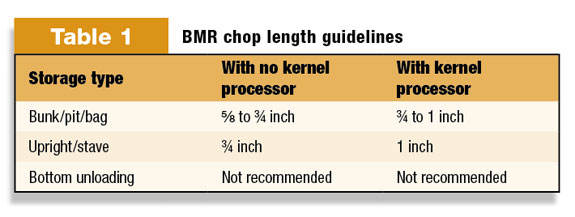Chop length, kernel processing and moisture content all influence silage fermentation, digestibility, feed intake and, ultimately, cow performance.
Regardless of current milk prices, input costs or other variables, milk production remains a dairy producer’s highest priority.
One of the fundamentals of achieving milk production is dry matter intake (DMI). To understand how chop length and other harvest factors affect DMI, it’s helpful to understand how the rumen works.
The rumen acts as a fermentation vat. The rumen microbial population is responsible for fermentation and is sensitive to changes in rumen pH.
Proper pH is needed to optimize the number of microbes and increase digestibility. Rumination or “cud-chewing” produces saliva, which helps maintain rumen pH.
Consumption of too-finely processed forages decreases rumination. Diets with too many small particles result in feed spending less time in the rumen and less microbial digestion.
Ideal particle size depends on the forage, but as a general rule corn silage should be chopped at ⅜- to ¾-inch. It is important to watch particle size regardless of the type of forage, but even more so with a highly digestible forage like BMR corn silage.
Because of the lower lignin and higher digestibility of BMR, it is necessary to manage the rate of passage through the rumen by maintaining adequate effective fiber.
Chopping at a longer particle size will help slow digestion and prevent upsets.

Follow these chopping recommendations to ensure adequate effective fiber in BMR corn silage (see Table 1).
The length of cut on a forage harvester can be adjusted by changing the feedroll speed or the number of knives.
Increasing the feedroll speed will increase the length of cut and should be the first adjustment made to increase the length.
Particle size at harvest also will be affected by knife sharpness, harvest speed, shear bar setting and crop moisture.
Increasing the length of cut has benefits in field performance as well, such as reduced fuel consumption and increased machine capacity.
Producers should check the machine length of cut, adjust it correctly and maintain the harvester to ensure top performance.
Another factor in corn silage particle size is mechanical processing. Silage processing can improve ensiling characteristics as well as improve starch digestion by exposing the corn kernel to rumen bacteria.
Although processing offers the potential for better nutrient utilization, it also can reduce particle size. Because BMR hybrids have moderately textured kernels, less aggressive processing is recommended to maintain adequate particle size in BMR corn silage.
Moisture level at harvest is another issue that is critical to creating high-quality silage. Use a precise method to test moisture levels for harvest.
Harvesting too dry could lead to improper packing; too wet to improper fermentation. One testing option is the Koster tester, a portable, forced-air electric drying unit. A microwave also can be an accurate tool of measurement.

Optimum moisture content at harvest may vary depending on the type of corn silage. BMR corn silage, for example, is generally chopped at higher moisture content. Follow these guidelines for your type of silage and storage structure (see Table 2).
Remember that corn continues to mature and whole-plant moisture can be significantly less when you finish chopping than when you start. A common mistake is to chop when the corn plant is past its optimum moisture level.
Finally, oxygen is your enemy when making quality silage. Rapidly exclude air by filling quickly and packing tightly. This will speed the production of lactic acid and drop the pH of the silage quickly, helping the rumen do its best work.
As you plan for silage harvest this season, take time to understand how decisions made at harvest impact silage quality and feeding value. Consult the herd nutritionist for guidelines on chop length, kernel processing and moisture content to ensure your harvested silage meets feeding and cow performance goals. FG
References omitted due to space but are available upon request.












